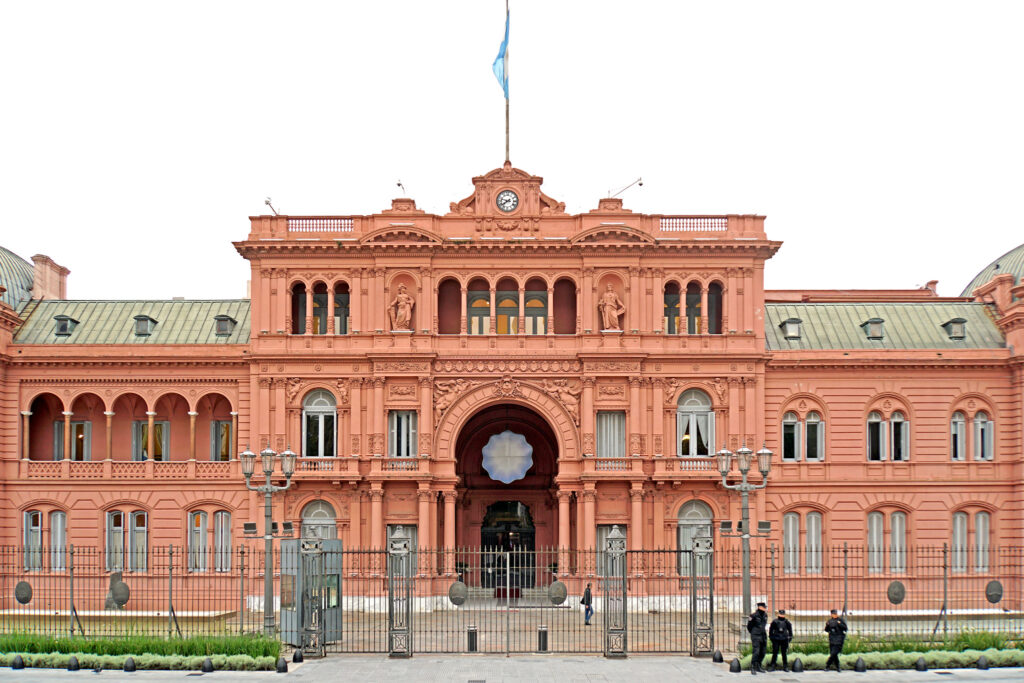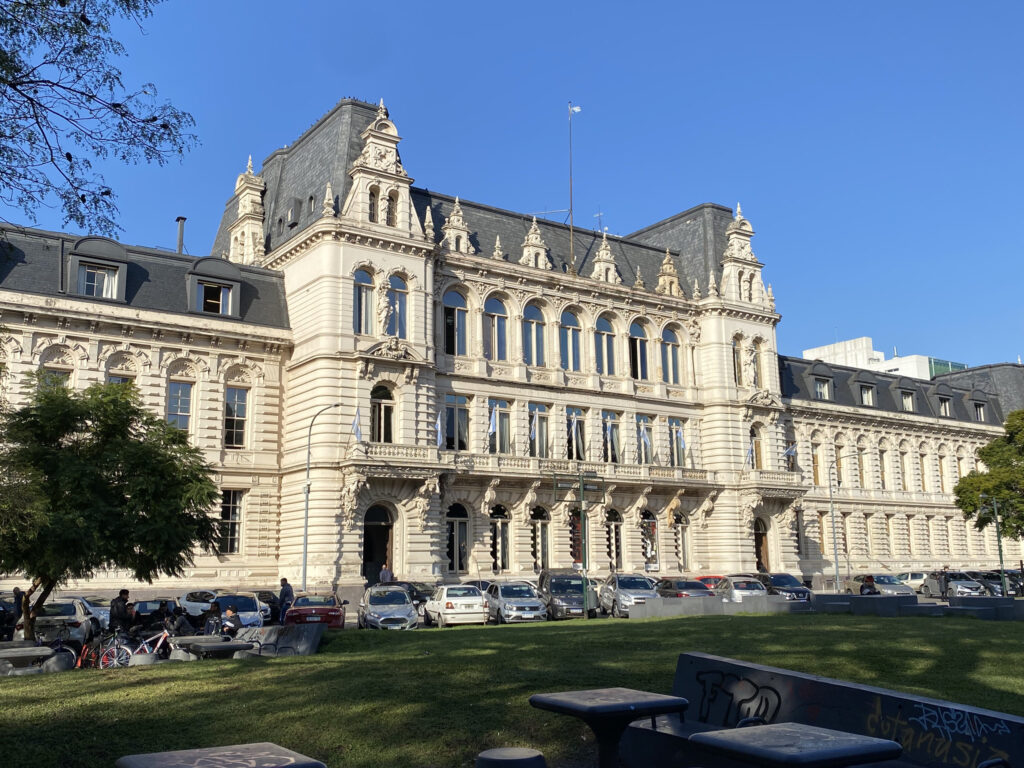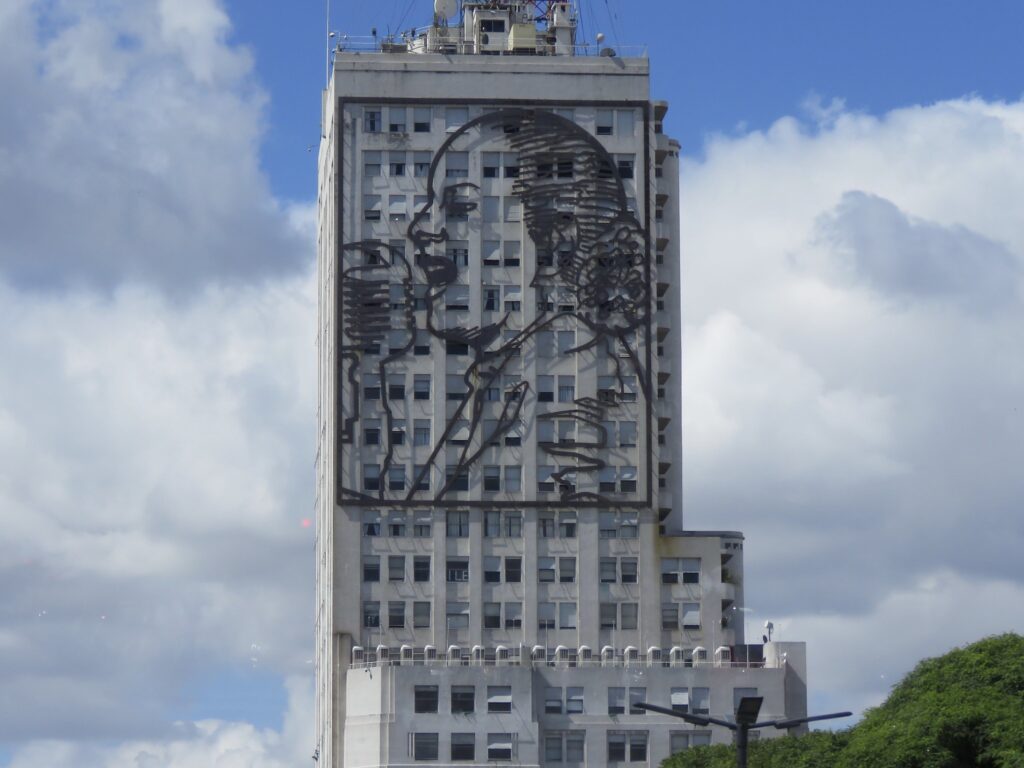Are you a curious traveler, digital nomad, or expat captivated by stunning architectural feats? Buenos Aires boasts an array of governmental buildings that are not only centers of bureaucracy but also bastions of cultural heritage and architectural wonder.
ExpatPathways invites you to explore “The 10 Best Incredible Government Buildings in Buenos Aires,” each a testament to the city’s rich history and vibrant aesthetic.
From the historic opulence of the Aduana de Buenos Aires to the brutalist beauty of the Biblioteca Nacional Mariano Moreno, these landmarks offer a unique glimpse into the soul of Argentina’s capital.
Prepare to be amazed by the stories these walls tell and the grandeur they embody in the heart of Buenos Aires.
The Best Incredible Government Buildings in Buenos Aires
1) Casa Rosada
Location: Balcare 78, Plaza de Mayo, Retiro.
The Casa Rosada, the iconic pink-hued palace in Buenos Aires, serves as the seat of the National Government and stands on the site of the original Fort of Buenos Aires established in 1580.
This building, a merger of the former presidential office and the Post Office Palace, features an architectural style that is a melange of French mansards, Italian loggias, and classical elements crafted under the direction of Italian architect Francisco Tamburini.

The expansive complex, marked by its historical depth, stretches across three levels on Balcarce Street and an additional four levels plus a basement along Avenida Paseo Colón, covering nearly an entire city block.
Noteworthy is the central arch on Balcarce 50, a unifying feature completed around 1890 that signifies the transformation of the site from a colonial fort to a modern governmental palace.
Despite modifications over the centuries, including the demolition of its southern wing and various decorative changes, the Casa Rosada remains a testament to the city’s rich history and architectural evolution, prominently located opposite the historic Plaza de Mayo.
2) Congreso de la Nación
Location: Av. Entre Ríos, Av. Rivadavia & Hipólito Irigoyen, Congreso.
The majestic Congress Building, an emblem of Argentine legislative power, anchors the urban landscape of Buenos Aires and embodies the grandeur of high Italian academicism of the late 19th century.
Initiated in 1889 and completed in stages with its final touches in 1946, the building is distinguished by its massive dome—80 meters high and supported by a sophisticated engineering structure—which was the tallest in Argentina at the time.
Designed by Vittorio Meano and adorned with sculptures by Lola Mora, the Congress Building features a complex facade with Corinthian columns, a hexastyle portico, and numerous artistic details, including a quadriga on its rooftop symbolizing the triumph of the Republic.
This building not only serves as a monumental venue for Argentina’s legislative activities but also stands as a national historical and artistic monument, its design and scale reflecting the cultural and civic aspirations of Argentina at the turn of the century.
3) Casa de la Cultura
Location: Av. de Mayo 575, Retiro.
Originally the headquarters of the La Prensa newspaper, the Casa de la Cultura in the Monserrat neighborhood near Plaza de Mayo is one of the most luxurious 19th-century buildings in Buenos Aires.
This opulent structure, now owned by the City Government, hosts a variety of shows, courses, and workshops and includes public offices. Built in 1898 by engineers Carlos Agote and Alberto Gainza, the building features stunning interiors by French companies, including the magnificent Golden Hall.
It has retained many original features such as a pneumatic tube communication system and a bronze lantern topped with a statue of Palas Atenea, symbolizing wisdom.
Its rich history and multifunctional design have made it a precursor to modern cultural centers, offering a blend of historical architecture and contemporary cultural function.
This building has undergone various restorations to preserve its intricate murals and convert its basements, which formerly housed printing presses, into exhibition spaces, further emphasizing its role as a cultural hub.
4) Biblioteca Nacional de Maestros
Location: Pasaje Pizzurno 953, Barrio Norte.
Housed in the historic Palacio Sarmiento, the Biblioteca Nacional de Maestros is a specialized public library focused on education sciences and pedagogy.
Located in Buenos Aires, it operates under the Ministry of Education and possesses a collection of over 220,000 items, including books, journals, and videos.

The library, which began as a book distribution center in 1870 under the initiative of Domingo Faustino Sarmiento, has evolved into an important resource for educational support. It provides a wide range of services, both in-person and online, to facilitate access to its vast resources.
The building itself, a Germanic-style edifice constructed between 1886 and 1888, initially served multiple educational purposes and later became the seat of the National Council of Education.
Today, it remains a cornerstone of educational support and historical preservation, enriched by contributions from renowned directors like Leopoldo Lugones, who significantly expanded its collections and services during his tenure.
5) Edificio del Ministerio de la Salud y de Desarrollo Social
Location: Av. 9 de Julio 1925, Monserrat.
The building that now houses the Ministry of Health and Social Development was inaugurated in 1936 as the headquarters for the Ministry of Public Works and was the first skyscraper on Avenida 9 de Julio, Buenos Aires’ principal boulevard.
Designed by architect José De Hortal in a rationalist style that emphasizes natural light and ventilation, this building stands out for its historical significance and iconic status in the cityscape.

It gained national monument status in 2002, and its facade was restored in 2010, preserving its resemblance to other period landmarks like the Kavanagh Building and the Gran Rex cinema.
The building is notable not only for its architectural merits but also for hosting the first television broadcast in Argentina from its terrace in 1951.
Since 2011, it features two monumental steel murals of Eva Perón on its north and south facades, created by sculptor Alejandro Marmo, symbolizing its cultural and social significance.
6) Casa del Gobierno de la Ciudad de Buenos Aires
Location: Uspallata 3150, Parque Patricios.
Designed by the renowned architect Norman Foster, the Buenos Aires City Government House is a model of sustainable architecture and the first public building in South America to achieve LEED certification.
Located in the Parque Patricios neighborhood, the building spans 38,000 square meters and features an innovative design that includes a floating, undulating roof supported by pillars that shades the entrance plaza.
The use of glass walls, terraced office floors, internal gardens, and shaded walkways integrates the structure with the surrounding landscape, optimizing natural lighting and ventilation.
This building is not only a seat of government but also a cornerstone in the urban regeneration of the area, aiming to attract high-tech industries and foster social inclusion.
Its design reflects the industrial past of the locale while promoting a sustainable and vibrant working environment. This project by Foster and Partners marks their first office project in Argentina and has been lauded for its sustainable construction and positive impact on the local community.
7) Banco Central de la República Argentina
Location: Uspallata 3150, Parque Patricios.
The headquarters of the Central Bank of Argentina, located within a block framed by San Martín, Reconquista, Teniente General Perón, and Sarmiento streets, showcases a mix of architectural styles reflecting its historical evolution.
Initially occupying the building of the former Provincial Mortgage Bank built in 1872, the complex expanded over the decades, culminating in a set of buildings that today cover a vast area of 60,000 square meters.
Each addition, including the notable structures at Reconquista 250 and 266, has been designed to preserve the cohesive aesthetic of the complex, contributing to its status as an architectural icon in Buenos Aires.
This historical site was declared a National Historical Monument in 2005 and underwent a major restoration in 2022 to preserve its original splendor, including a detailed analysis of its façade’s composition and coloration.
The Central Bank’s buildings not only serve an essential financial role but also stand as monuments to Argentina’s rich banking history and architectural heritage.
8) Palacio de Aguas Corrientes
Location: Riobamba 750, Recoleta.
The Palacio de Aguas Corrientes, officially known as the Gran Depósito Ingeniero Guillermo Villanueva, is a striking example of utilitarian architecture dressed in lavish materials, located on Avenida Córdoba in the Balvanera neighborhood.
Constructed between 1887 and 1894 to house the city’s water tanks, the building features a facade adorned with over 300,000 pieces of imported ceramics and bricks, creating a vivid display of eclectic architecture reminiscent of the French Second Empire style.
The Palacio was designed to be both functional and ornamental, embodying the period’s penchant for grandeur in public works. Its interior supports a massive iron structure that holds twelve tanks with a capacity of 72 million liters of water, distributed across three levels.
This building not only represents a significant engineering feat but also a cultural and historical artifact, reflecting the ambitions and aesthetic values of late 19th-century Buenos Aires.
It stands today as a National Historical Monument, admired for both its external beauty and its crucial role in the city’s development.
9) Aduana de Buenos Aires
Location: Av. Comodoro Py 1905, Retiro.
The Buenos Aires Customs House, situated at Azopardo 350, is a monument to Argentina’s trade history and its architectural heritage.
Designed by architects Eduardo Lanús and Pablo Hary, the building was inaugurated in 1910 and declared a National Historic Monument in 2009.
This site has been integral to Buenos Aires since its founding in 1580, with the customs house moving locations several times due to urban developments, including the creation of Puerto Madero.
Its current structure, built on land reclaimed from the river, epitomizes the academicism style with Paris stone-like facades, two striking towers visible from Puerto Madero, and a grandiose symmetry that commands the entire block.
Despite losing much of its original ornamental sculpture in recent restorations, the building retains its majestic presence, serving as a critical node in Argentina’s import and export activities.
The customs house not only supports logistical functions but also stands as a testament to the architectural and functional evolution of governmental buildings in Buenos Aires.
10) Biblioteca Nacional Mariano Moreno
Location: Agüero 2502, Recoleta.
Founded on September 13, 1810, by Mariano Moreno, the Biblioteca Nacional Mariano Moreno is Argentina’s most significant library and a repository of the country’s cultural memory.
Located in the Recoleta neighborhood, the library’s current building, an outstanding example of brutalist architecture, was designed by Clorindo Testa in collaboration with Francisco Bullrich and Alicia Cazzaniga.
It was inaugurated in 1992 on the site of a former presidential residence. The structure is notable for its raw concrete forms and an elevated platform that integrates seamlessly with the surrounding park, providing panoramic views of the city and the Rio de la Plata.

The library houses over 220,000 items, including rare manuscripts, early printed books, and a vast hemeroteca, making it the largest of its kind in Latin America.
Its design reflects a modern ethos where functional spaces such as book depots are submerged underground, preserving the materials from light damage while allowing public spaces to dominate the above-ground structure.
This design approach not only protects the collection but also creates an inviting public space that enhances the community’s educational and cultural experience.
(Featured Image Source: María Julia/flickr.com)


